Samsung NX200 Review
Samsung NX200
At 20.3MP it certainly packs plenty of resolution, but does the NX200 deliver the image quality to match?
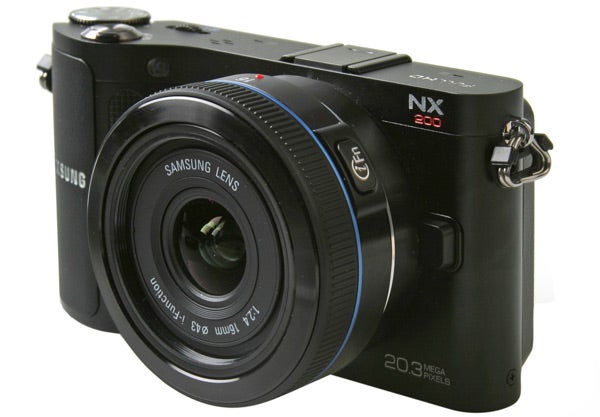
Verdict
Pros
- Excellent overall image quality
- Delivers plenty of detail
- Solid build quality
Cons
- Not the most comfortable camera to hold
- Detachable flash feels a bit flimsy
- Image processing while in Continuous drive mode is a bit slow
Key Specifications
- 20.3MP APS-C CMOS sensor
- ISO 100 to 12,800
- 3inch, 614k-dot AMOLED monitor
- 7fps Continuous shooting (max 11 images)
- 1080/30p Full HD movie recording

Samsung isn’t exactly a complete newcomer to CSCs. Indeed, the company has been enthusiastic early adopter of the standard, announcing within weeks of the launch of the Micro Four Thirds standard that it would be focusing on a CSC standard of its own. Since then the company has abandoned DSLR manufacturing altogether to concentrate instead on its NX range of CSCs.
In the intervening years we’ve seen the NX100 make its debut, along with the more DSLR-styled NX10 and NX11 models. As the direct successor to the nearly 18-month-old NX100, the NX200 looks to up Samsung’s game considerably.
In terms of construction the NX200 benefits from more metal and less plastic, while movie recording jumps to 1080p Full HD from the 720p HD capabilities of the NX100. Likewise, maximum burst rate rise to 7fps (from 3fps). Perhaps most eye-catching of all though is a brand new APS-C CMOS sensor with an effective resolution of 20.3MP – a considerable improvement over the 14.6MP of the NX100 and second only to the 24.3MP Sony NEX-7 within its class.
Of course with all the hardware and specification improvements, the NX200 doesn’t come particularly cheap. Discounting means the camera body and 20-50mm kit zoom package can be sourced for around £550 online, putting it up against the likes of the 16.1MP Sony NEX-5N (c.£550 with 18-50mm), 16MP Panasonic Lumix GX1 (c.£550 with regular 14-42mm kit zoom), 12.3MP Olympus E-P3 (c.£700 with 14-42mm), and to perhaps a lesser extent, the more novice-friendly 10.1MP Nikon J1 (c.£400 with 10-30mm).
Stiff competition from all sides, then. Lets take a closer look and see if the NX200 has what it takes to compete…
The Samsung NX200 is built around an all-new APS-C CMOS sensor that is manufactured by Samsung and which offers an effective resolution of 20.3-megapixels. Maximum output at full resolution in the default 3:2 aspect is an impressive 5,472 x 3,648 pixels – of all the compact system cameras currently on the market only the 24.3MP Sony NEX-7 outputs higher. Sticking with 3:2, resolution can be reduced to 10.1MP, 5.9MP and 2MP, with further options to shoot in16:9 and 1:1 at slightly reduced resolutions. There is, however, no option to shoot in 4:3.
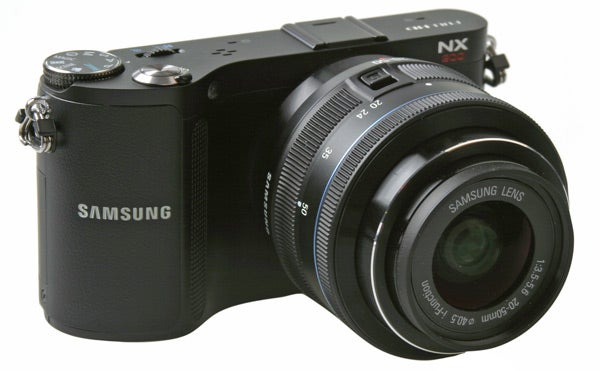
The NX200 can record both JPEG and lossless Raw (.SRW) image files, with three levels of JPEG quality: SuperFine, Fine and Normal. You can expect images shot at maximum resolution in the SuperFine setting to equal around 7-9MB in size, although this will of course vary, depending on the complexity (colour saturation, available light, number of sharp edges etc) of the scene being photographed.
Exposure metering is handled via a 221-pixel TTL module, with the camera able to capture a maximum dynamic range of 18 EV. It’s also possible to dial in ±3 EV compensation however there is no AEL button with which to lock exposure in tricky light, which is a little disappointing for an advanced camera of this type. Sensitivity, meanwhile, ranges from a baseline ISO 100 up to 12,800, which is fairly standard for an upper-level CSC like this.
Looking at the exposure mode dial, it comes as no surprise to find all of the regular semi- and fully manual options: Program, Aperture-priority, Shutter-priority and Manual. These are complimented by a range of point-and-shoot modes including 15 individual Scene modes and a Smart Auto mode that automatically detects and selects what the camera believes to be the correct Scene mode for whatever it happens to be faced with.
The NX200 also comes with Samsung’s own easy-to-use Panorama mode that enables you to create high quality 180-degree panoramic images simply by sweeping the camera in a predetermined direction with the shutter button held down. Additionally, the NX200 also offers a Magic exposure mode that’s split into a generous selection of Smart Filter digital effects, along with some Magic Frame border deisgns. While the Smart Filters offer some easy-to-use creative effects, the Magic Frames are pretty cheesy and feel distinctly out of place on a camera of this calibre.
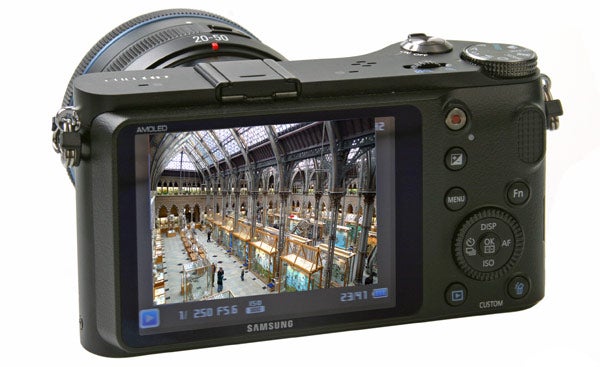
The final notch on the exposure mode dial is given to Lens Priority mode, which uses the lens-mounted iFn (intelligent Function) button to toggle between the NX200’s various Scene modes and the digital zoom. While the iFn button is undoubtedly a clever idea and a well executed one at that, we do think that it’s infinitely more useful when shooting in one of the regular PASM modes where it can be customised to switch between other shooting functions, turning it into a kind of Quick menu/additional Function button.
As might be expected the NX200 offers excellent movie recording abilities, with a maximum capture setting of 1080/30p Full HD. This is complemented by additional options to record at 720/60p HD, 720/30p HD, 640×48/30p VGA and 320 x 240/30p QVGA – a clear improvement over the 720p top setting of the NX100. Sound is recorded in stereo via two microphones positioned on the top of the camera body but there’s no port with which to attach an external microphone.
The NX200 ditches the mostly plastic chassis of its predecessor in exchange for a predominantly metal outer casing. The silver top-plate of the previous model has gone too, with the NX200 instead treated to a classy matt black and faux leather finish. Picking it up for the first time the NX200 body feels well made and solid, if not a little angular.
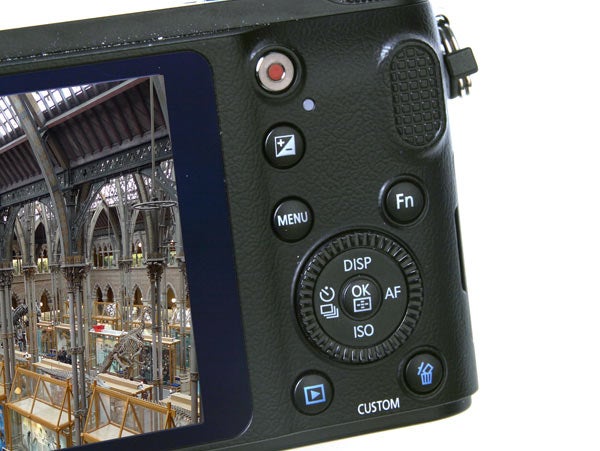
Indeed, these sharp lines and flat surfaces are very much the defining traits of the NX200, at least in terms of aesthetics and handling. The NX100 was undoubtedly a much curvier camera overall. The edges of the NX200 are much sharper too, compared to the filed edges of the NX100 and most other cameras of this type. Even the handgrip has little concession for finger and hand comfort in the shape of rounded corners.
Does this make the new model harder to grip? Yes and no. It’s certainly true that all the sharp edges don’t make the NX200 the most comfortable camera to hold, however the restyled grip works pretty well and is big enough for three fingers. The textured strip where the tips of your fingers naturally sit adds a bit of extra grip too. Along with the textured thumb rest on the back it’s possible to hold the NX200 quite securely. Of course, for additional security you should also attach the supplied neck strap.
Physical buttons are generally quite well spaced offering direct access to all of the most regularly accessed settings, including ISO, Drive mode, AF selection point and suchlike. The NX200 does lose the AEL button of the NX100, replacing it with a one-touch movie record button instead (although you can still lock exposure to the AF point should you wish to). While we can appreciate that many users want to be able to record movies without delay, a dedicated AEL/AFL button often proves invaluable to more advanced shooters.
That said, we especially like how the Fn button on the back of the camera can be used to call up a tiled Quick Menu that’s really intuitive to use, which in turn enables you to quickly access and make changes to your key shooting settings. The main menu also proves easy to navigate in order to access more in-depth settings.
In keeping with its predecessor the NX200 lacks a built-in flash. Samsung does however bundle the NX200 with a small two-position flash that attaches to the hotshoe. When angled down this flash is automatically switched off make to make the overall camera package more compact and prevent the flash from firing mistakenly. While it certainly works, it’s hardly the neatest or tidiest solution and also feels a bit flimsy next to the robust metal body of the NX200.
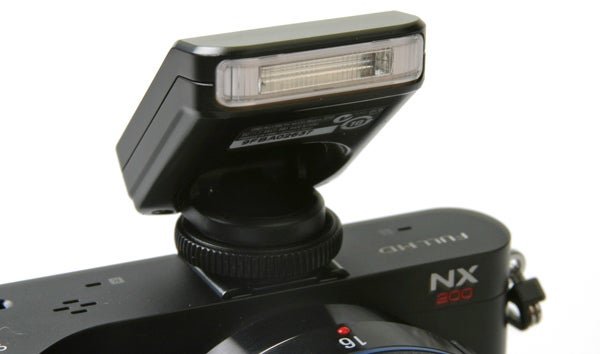
On the back of the NX200 you’ll find a 3-inch AMOLED-type monitor. This produces a bright, colourful and detailed image and offers an especially wide viewing angle although (as is typical for AMOLED displays) we’ve found it can sometimes serve up a slight blue or green hue, especially when viewed from an angle.
Start-up time is around the one-second mark, and while the headline continuous shooting speed of 7fps is pretty good too, overall performance is a little hampered by somewhat pedestrian processing speeds – not altogether surprising given the size of the files produced by the camera when used at full resolution.
With the NX200 set to Continuous (high) drive mode, it’s possible to record a total of 10 JPEGs at full resolution and super-fine quality before the buffer is full. From here it takes about 12 seconds for the camera to process the images, during which time the camera cannot record any new ones. Switching to Raw recording things slow down considerably, with the camera able to record eight consecutive images before grinding to a halt, from where it takes approximately 35 seconds to process them. Combined Raw and JPEG shooting is slightly slower still, with a maximum eight consecutive frames taking 40 seconds to process – you better hope you got the shot within those first 8 frames!
Overall image quality is some of the best we’ve yet seen in a CSC and certainly on a par with what the APS-C equipped Sony models can achieve. The NEX200’s 20.1MP APS-C sensor is capable of delivering impressive amounts of fine detail – especially at lower ISO settings – as well as giving you plenty of license to crop your images post-capture.
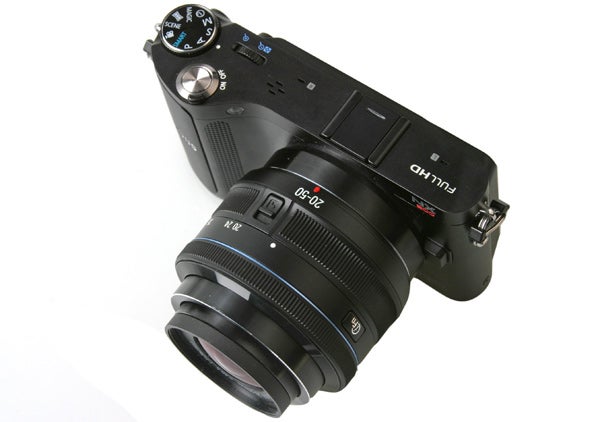
Our review sample came fitted with the standard 20-50mm, f/3.5-5.6 kit zoom that comes bundled with the camera. While it does feel a bit plasticky, it’s more than capable of producing detailed images, with the edges and corners remaining as sharp as the centre – especially when the aperture is set to its sweet spot of around f/7. Chromatic aberrations are notably well controlled too, with few unsightly purple fringing on high contrast borders.
As with most digital cameras these days the NX200 features the ability to shape the look of your JPEG images with a series of Picture Wizard presets and custom slots. We tended to stick with the Standard setting for the majority of our test shots although there are no fewer than 11 other settings to choose from: Vivid, Portrait, Landscape, Forest, Retro, Cool, Calm, Classic, and three Custom slots. Within each of these settings it’s possible to tweak the colour, saturation, sharpness and contrast settings as you wish.
While images shot on the Standard setting do sometimes come out of the camera looking a little tonally flat, it does provide a very good starting point, especially if you’re shooting in Raw and prefer to bump things up yourself in editing software. If, on the other hand, you want richly saturated or deliberately flat images then the Picture Wizard controls will go a long way towards helping you achieve your desired look.
As well as Picture Wizard controls the NX200 offers a number of additional image tweaking controls including a Smart Range function that can be used to increase dynamic range by increasing highlight retention. Examining images the difference between having the feature switched on and off is actually quite subtle and you need to go looking for it, however as an APS-C camera the NX200’s dynamic range is pretty good anyway – noticeably better than that of small-sensor cameras in any case. 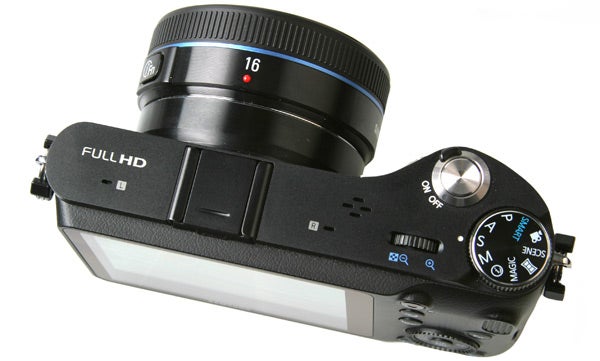
Of course, another advantage of the NX200’s APS-C sensor is the camera’s ability to attain a shallower depth of field than might otherwise be the case. This is particularly useful for portraits where you want to pull your subject out of the background.
Sensitivity is yet another area where image quality excels. We don’t mind admitting that prior to picking the camera up we did had some doubts over pixel density, however these largely proved to be unfounded. At lower sensitivity settings of between ISO 160 and ISO 400 noise isn’t visible at all in images, while at ISO 800 it’s only really noticeable when the image is viewed at 100% or more. At ISO 1600 some softening does occur and this is more pronounced at ISO 3200, although images still remain perfectly useable at smaller sizes. Beyond this the softening effects of the camera’s noise-reduction algorithms become noticeable even at smaller sizes, with ISO 12,800 also displaying an abundance of red chroma noise, making it practically unusable.
Verdict
Samsung continues to impress us with its digital camera output. The NX200 builds quite significantly on the strengths of its predecessor to deliver punchy images bursting with detail. While the NX200’s higher than average resolution is likely to remain the headline-grabbing spec, the real selling point is overall image quality, which is undoubtedly a match for many DSLRs costing more money. Ergonomics, while sharp, clean and modern, could be a little more hand-friendly though. That said, if you’re looking for an APS-C equipped compact system camera then the NX200 delivers enough to warrant a place on your shortlist.

ISO 160 is free of noise with good shadow detail

Likewise, ISO 200 is also noise-free with plenty of detail in the shadow areas

At ISO 400, the image remains sharp with only the merest hint of shadowing in the shadows

At ISO 800 a loss of detail in shadow areas becomes noticeable – but only when images are viewed at 100% or more

At ISO 1600 this softening begins to become noticeable regardless of viewing size

By ISO 3200 the effects of noise and noise-reduction have begun to take hold

By ISO 6400 the image is beginning to fall apart

And by the top setting of ISO 12,800 images have become a soft, fuzzy mess
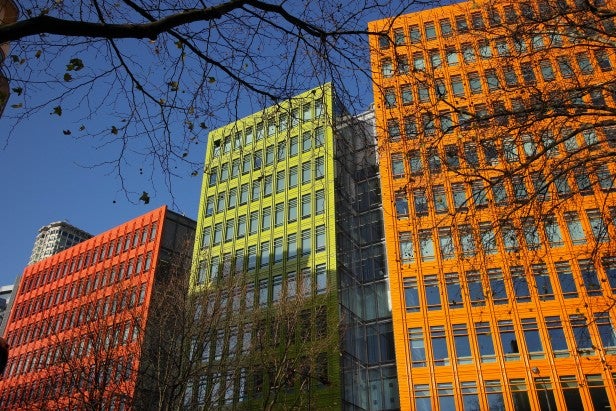
1/1250sec @ f4, ISO 200, 30mm, AWB

1/50sec @ f/5, ISO 200, 67mm, AWB
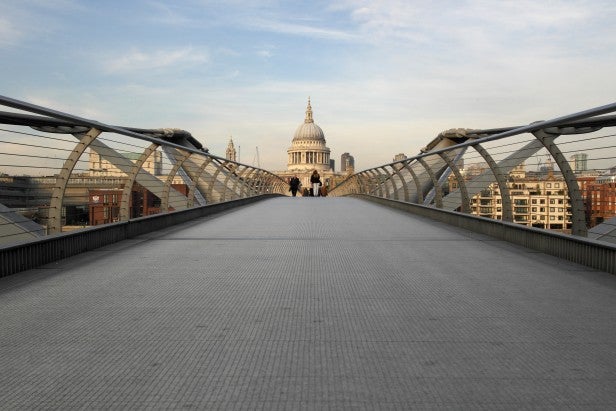
1/640sec @ f/6.3, ISO 400, 30mm, AWB
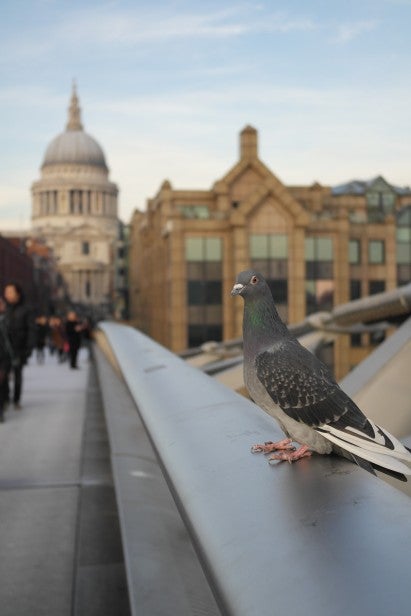
1/400 sec @ f/4.5, ISO 400, 45mm, AWB
Trusted Score
Score in detail
-
Value 7
-
Design & Features 8
-
Image Quality 9
-
Build Quality 9
Features
| Camera type | Mirrorless Camera |
| Megapixels (Megapixel) | 20.3 Megapixel |
| Optical Zoom (Times) | n/ax |
| Image Sensor | APS-C CMOS |
| Optical focal length | n/a |
| Shutter speed | 1/4000 to 30sec, Bulb |
| Auto focus | Contrast-detect: Single AF, Continuous AF, MF |
| Manual focus | Yes |
| Max output resolution | 5472 x 3648 |
| Other resolutions | 10.1MP, 5.9MP, 2MP |
| Focus range | n/a |
| Exposure control | PASM, Scene, Smart Auto, Panorama, Lens Priority |
| Exposure metering | TTL 221-block segment |
| Exposure compensation | +/- 2EV |
| Image Stabilisation | Yes |
| Viewfinder | No |
| Video (max res/format) | 1080/30p Full HD |
Physical Specifications
| Dimensions Width (Millimeter) | 116.5mm |
| Depth (Millimeter) | 36.6mm |
| Length (Millimeter) | 62.5mm |
| Weight (body only) (Kilogram) | 220.4kg |

